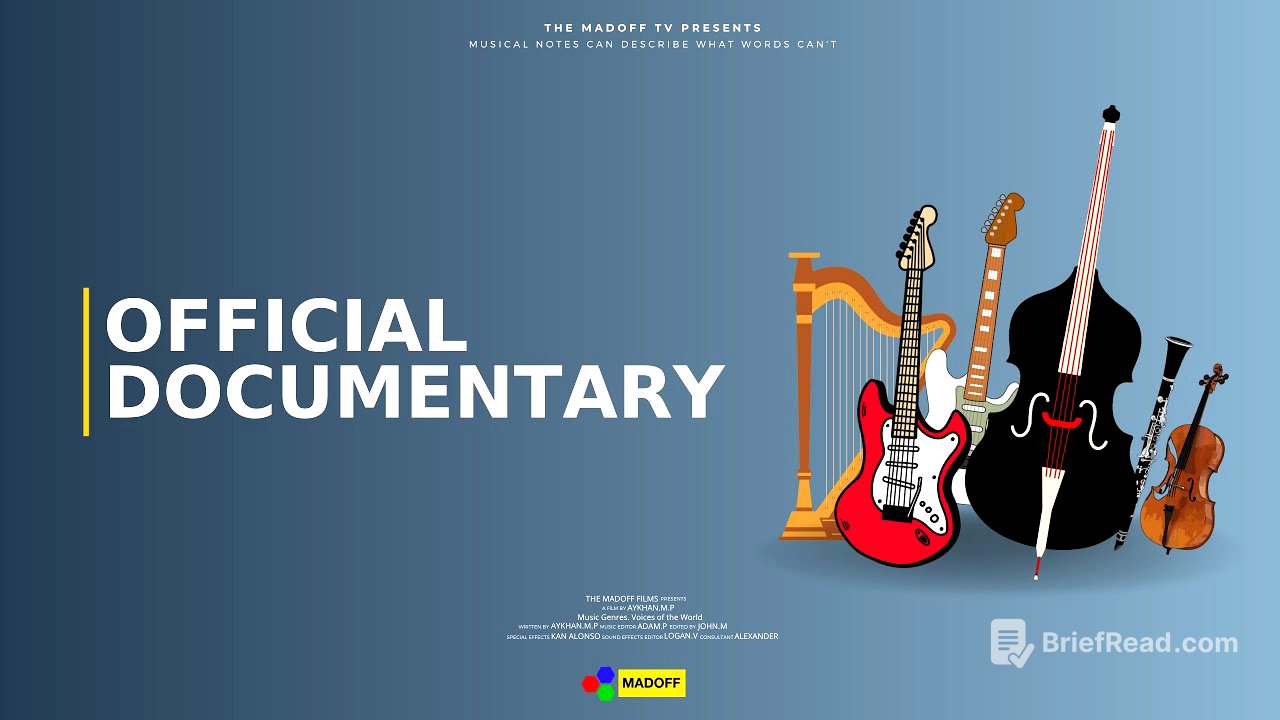TLDR;
This documentary explores the evolution and impact of various music genres, highlighting their historical roots, key artists, and cultural significance. It emphasizes music's role as a universal language that unites people, reflects societal changes, and inspires across generations. The journey covers classical, jazz, rock, pop, hip-hop, reggae, blues, country, and electronic music, showcasing their unique characteristics and contributions to global culture.
- Music is a global art that expresses emotions, ideas, and cultural nuances.
- Genres like classical, jazz, rock, pop, hip-hop, reggae, blues, country, and electronic music have unique histories and characteristics.
- Music unites people, inspires, and reflects social and cultural changes.
Classic Music [5:22]
Classical music is a genre known for its grandeur and sublimity, with roots tracing back to ancient civilizations. It flourished during the Baroque, Classical, and Romantic eras, encompassing subgenres like symphonies, operas, sonatas, and ballads. Orchestras, featuring instruments such as violins, cellos, flutes, and trumpets, are integral to classical music. Composers like Mozart, Beethoven, and Tchaikovsky have left an indelible mark on global culture, expressing deep feelings and thoughts of humanity. Classical music continues to influence culture, inspiring and enchanting millions worldwide.
Jazz Music [8:46]
Jazz emerged from the fusion of African-American and European musical traditions in the late 19th and early 20th centuries. It originated in the Southern United States, blending African rhythms, European harmony, and American musical heritage. Jazz flourished during the Prohibition era and served as a morale booster during the Great Depression. Subgenres include swing, bebop, fusion, and Latin jazz. Instruments commonly used are the saxophone, trumpet, trombone, double bass, piano, and percussion. Legendary musicians like Louis Armstrong, Duke Ellington, and Ella Fitzgerald have significantly contributed to jazz.
Rock Music [12:45]
Rock music originated in the mid-20th century in the United States, becoming a voice of freedom and rebellion. It started with rock and roll in the 1950s, inspired by African-American rhythm and blues and country music. The 1960s saw the British Invasion and psychedelic rock, while the 1970s brought hard rock and glam rock. The 1980s embraced new wave, heavy metal, and alternative rock, and the 1990s saw the rise of grunge. Subgenres include classic rock, hard rock, punk rock, and progressive rock. Key instruments are guitars, drums, bass guitars, keyboards, and vocals.
Pop Music [16:04]
Pop music's history began in the early 20th century with the rise of radio and phonograph records. It evolved with rock and roll in the 1950s and gained global recognition with groups like The Beatles in the 1960s and 70s. The 1980s saw the rise of electro-pop and synth-pop. Pop music incorporates elements of rock, rap, and electronic music. Subgenres include pop-rock, dance-pop, and synth-pop. Famous artists include Michael Jackson, Madonna, and Elton John.
Hip-Hop [19:11]
Hip-hop emerged from the streets of New York City in the 1970s as a means of self-expression for youth in disadvantaged areas. It includes rapping, beatboxing, graffiti, and breakdancing. Hip-hop addresses social problems, personal stories, and cultural identity. The 1990s marked its golden age with artists like Run DMC, 2Pac, and NWA. Subgenres include rap, trap, and gangster rap. Producers use sampling, beat-making, and synthesizers to create unique sounds.
Reggae [22:58]
Reggae originated in Jamaica in the second half of the 20th century, reflecting the island's soul and struggle. It expresses the desire for peace, equality, and freedom. The word "reggae" comes from "regation," referring to rhythmic patterns in Jamaican dialect. Bob Marley and Jimmy Cliff became key figures, conveying social messages through their music. Subgenres include dub, ska, and reggae rock.
Blues [25:24]
Blues music originated in the late 19th century among African-Americans in North America, born out of poverty and social discrimination. It served as a way to express feelings from grief to hope. The blues has inspired many genres and includes subgenres like jazz blues, Chicago blues, and delta blues. Instruments include guitar, drums, keyboards, and bass guitar. Legendary musicians include Robert Johnson, Bessie Smith, and Muddy Waters.
Country Music [27:23]
Country music was born in the American open spaces, conveying the daily life and feelings of people in rural areas. It combines folk music, European immigrant tunes, and African-American influences. With the development of television and recording, country music gained worldwide recognition. Subgenres include traditional country, contemporary country, and bluegrass. Traditional instruments include acoustic guitar, fiddle, and steel guitar.
Electronic Music [29:45]
Electronic music is a modern genre where sounds are created and manipulated using electronic devices and computer technology. It began in the mid-20th century with the development of electronic instruments and synthesizers. The 1980s saw the rise of house and techno cultures. Subgenres include trance, house, dubstep, and techno. Basic instruments include synthesizers, samplers, and computers.









